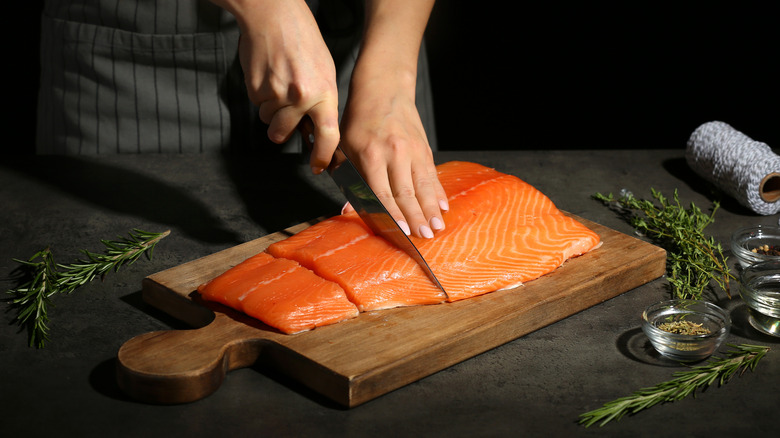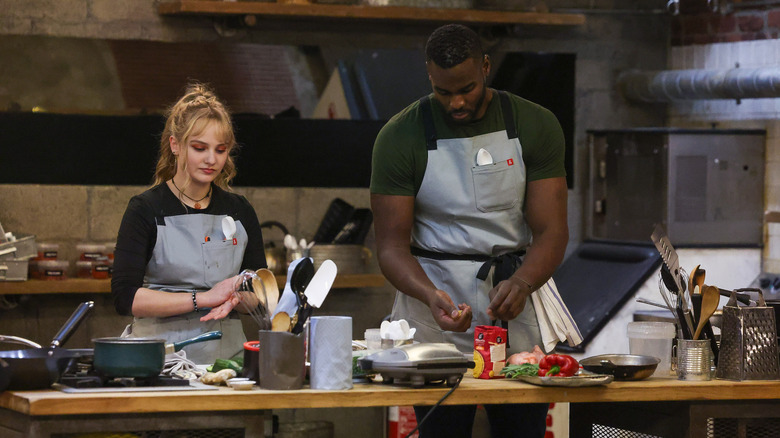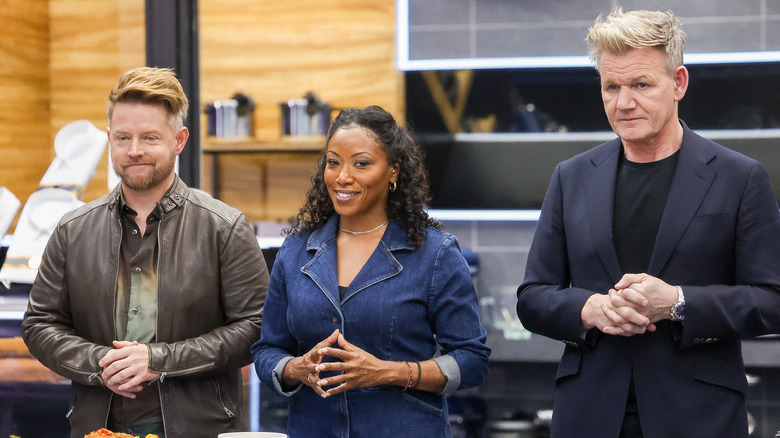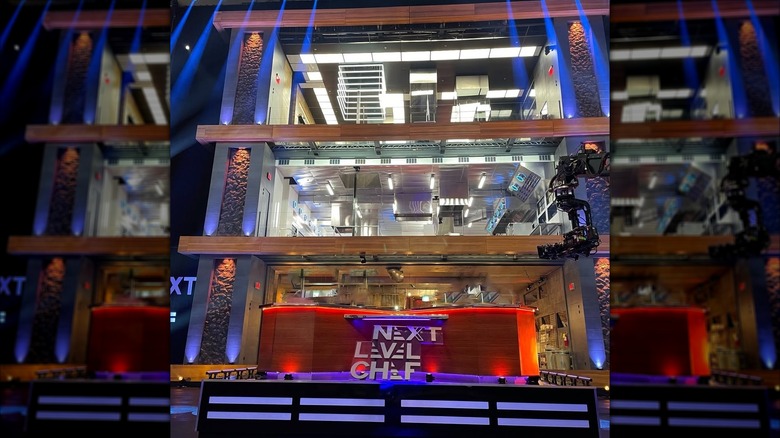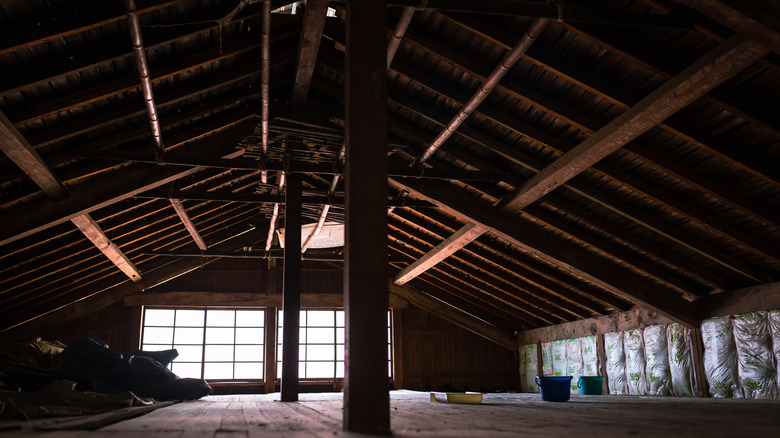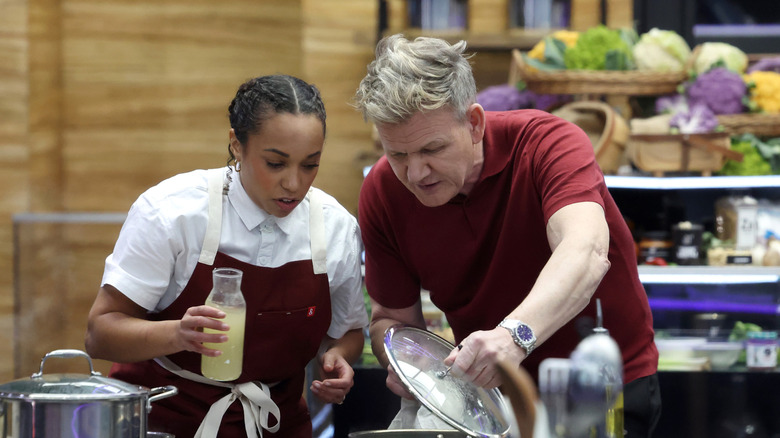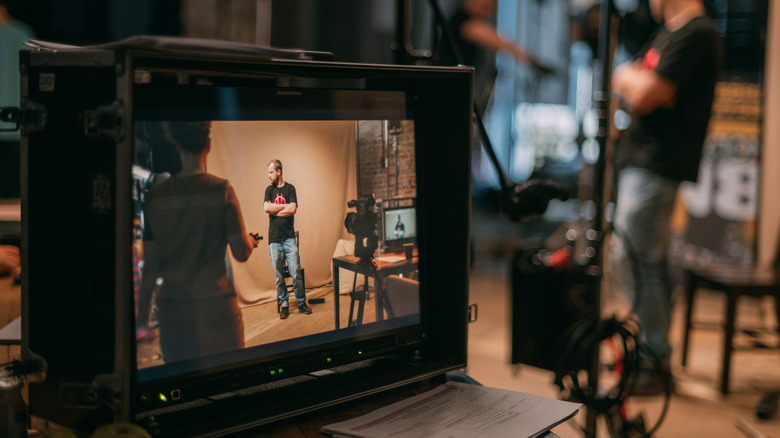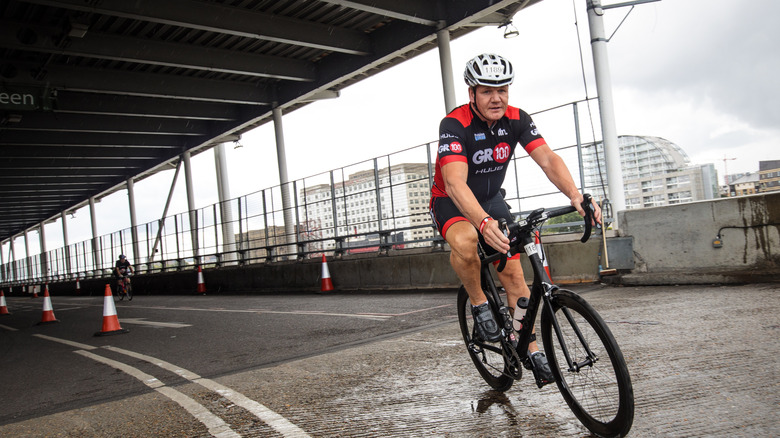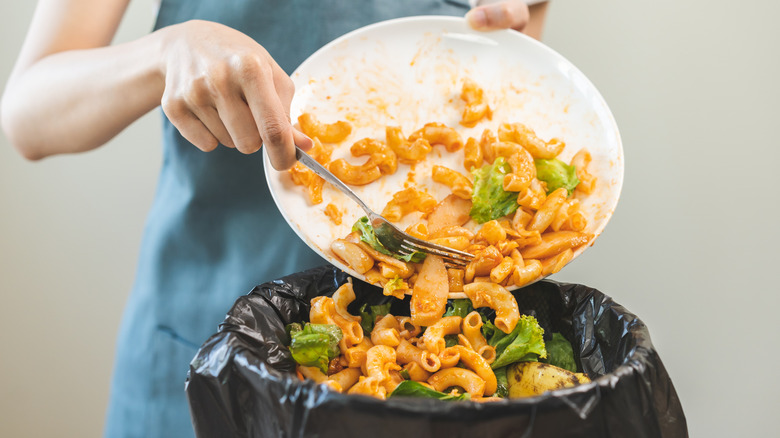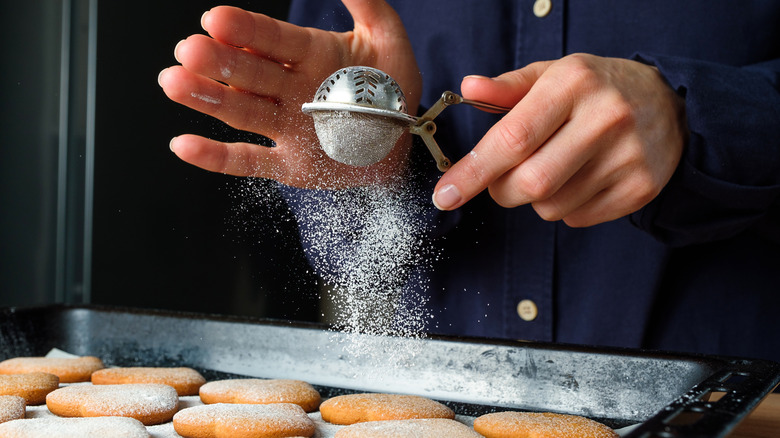What The Cameras Don't Show You On Next Level Chef
In a world full of competition cooking shows, it is rare to find a show that truly jumps out at you and demands attention. One look at "Next Level Chef," though, and it is hard to look away. The show is notable for its signature triple level stage with a moving platform of ingredients that travels between the levels. Each level offers a differently equipped kitchen, from the basement level with only the barest of equipment, to the top level that is a kitchen any chef would dream of. To say the show is eye catching would be an understatement. However, like with any television show, there is plenty going on that we as viewers never see.
With so many moving parts — quite literally — there is understandably a lot to this show that is never caught on camera. We spoke with producer and showrunner Matt Cahoon to find out what is going on behind the scenes that makes this show what it is. These are the behind-the-scenes facts and insights from "Next Level Chef" that the cameras don't show you.
There is a team of chefs working behind the scenes
Of course with a cooking show, you can't go far without finding a chef. Between celebrity guest judges Gordon Ramsay, Richard Blais, Nyesha Arrington, as well as the chefs competing on the show, there is clearly no shortage of chefs. But you might be surprised to find out there is also a whole team of chefs behind the scenes making sure that every ingredient that enters the kitchen is sourced and prepared at the highest standard.
In an exclusive interview, mentor Richard Blais revealed to us that the show keeps Michelin starred chefs on staff to prepare the food that goes into the kitchen. This may seem counterintuitive to the viewer at home, as the contestants cook the food, but the food must be processed before it makes it to the platform and has to be instantly ready to use. The food on the platform that moves through the levels of the kitchen is held to an incredibly high standard. Matt Cahoon elaborated that the chefs work tirelessly to ensure quality standards. Hired butchers do all the meat and fish preparation, and a team of chefs are there to source only the best fresh produce and ingredients for the show.
Additionally, chefs and stylists are on hand to set up the platform for each show, a task that takes several hours to complete. We might not see these chefs, but they are there, constantly preparing ingredients for the camera.
Finding the chefs is a daunting task
Each season showcases a new group of up-and-coming chefs, and producer and showrunner, Matt Cahoon gave us some insight into the truly laborious process of finding and vetting the best chefs for each season.
Any chef can apply to be on the show, and the casting team has to sort through thousands of applications. However, the process doesn't stop there. There is an additional team that scours food blogs, social media pages, and restaurant reviews finding the best of the best. A representative reaches out to those who the team thinks have what it takes to compete on the show. The whole process is incredibly rigorous and time consuming.
The casting team then has to narrow the chefs down to the final group who become the contestants on the show. It isn't just about being a talented chef, but also about having the potential to do well in the show and have good screen presence. Not only do the contestants have to be excellent chefs, they have to be able to think on their feet and take anything the show throws at them.
Judges don't try the food immediately
On the show it appears as though the challenge dishes go straight from cooking to the judges trying the food, but this isn't the case. Matt Cahoon tells us that after the challenge is complete, a team quickly, but carefully, whisks the prepared food to the judge's table. However, before they can actually bite into the food, the cameras have to take what are known as "beauty shots" of the food. These shots get featured in the show to allow viewers to get the best angle of each dish. As the food is transitioning between the stages and these necessary shots are done, it delays the mentors from trying the food for a bit.
The good news is, the show runs like a well-oiled machine and the judges aren't waiting too long. Even though they take this brief break in between challenges and judging, the goal is to try the food at peak quality. That means the culinary team and film team work quickly to ensure the food is still warm when it is tried by the mentors.
The iconic three-level set is an engineering feat
When watching the show, the set appears to work by magic. But in reality, a lot of engineering and manpower go into the show's iconic three-level set. As Matt Cahoon notes, functionally, the show has three full sets. Which means multiple crew members are needed for each set.
You may not see them, but behind each level is a whole crew making sure things run smoothly. Cahoon says each level has its own engineer operating the elevator, another one operating the elevator door, and an engineer manning the platform.
That's not all, though. In addition to impressive software requiring multiple engineers to keep running, the platform that rises up and down the three levels has custom designed software to ensure that the timing and speed of the platform is razor sharp and accurate. This means both the hardware and software for this are specially engineered, which is why we don't see anything like it elsewhere.
In addition to the core operating team, Cahoon tells us each floor also has one food stylist, one chef and producer, one assistant director coordinating movements, three camera operators, and a robo cam. All this to keep the incredible set going. There is also a fire marshal and a medic on each level just for extra safety.
There is a secret fourth level
The three level set is the most iconic part of the show, and indeed the whole premise of the show is built around the "levels" of the stage. But what if we told you that there aren't three levels to the set? There are actually four!
Matt Cahoon dropped the bomb on us that the set we all know has a secret fourth level called "the attic." The attic is 60 feet in the air, and as Cahoon told us, "the only requirement of working up there ... no fear of heights!"
This fourth level is where the magic happens that allows the show to run as smoothly as it does. The platform goes up to the attic and gets loaded and reloaded with styled food before descending to the kitchens below. It is the standing area for teams to prepare all the challenges. Of course, this means the team in the attic has to work at an incredible rate to keep things moving. Cahoon likened it to a NASCAR pit crew, but instead of changing tires and filling gas, they are prepping food and setting up challenges. While other shows have crews doing similar jobs, those crews typically aren't four stories up in an open stage. Truly they are some of the unsung heroes of the show.
Chefs do get a few staple ingredients
Part of what makes "Next Level Chef" a particularly difficult show to compete on is the restriction on ingredients. As the platform lowers from the top kitchen to the basement, contestants grab the best ingredients from the selection provided. For the most part, these are the ingredients the contestants must use to create their dishes. Contestants get 30 seconds to pick their items and it is always a chaotic time. Naturally, the basement level is left with the remaining options, which adds to the creativity needed to compete.
However, the producers aren't too harsh on the contestants. Matt Cahoon says each kitchen is stocked with a few pantry staples. In this case, eggs, milk, cream, butter, flour, and spices are provided. Everything else must be pulled from the platform during the 30 second grab period.
Interestingly, these ingredients are the same no matter which level you are competing on. Unlike the kitchens themselves, which diminish in quality as they go down, each kitchen is stocked with the same pantry items to create an equal playing field in terms of ingredients.
Set up takes longer than an episode
With such an intricate set, it is no wonder that set up takes a long time, but in this case, the set up takes longer than an episode. Just to get the kitchens up and running, the team has to ensure that the electricity is functioning and the gas is on, plus complete a full check of all the equipment.
To get everything ready, Matt Cahoon says takes 90 minutes and that is before any actual cooking even happens. Most of this would need to be done for any show, but because of the triple level nature of "Next Level Chef," there is even more to check and double check before things get going. This helps keep everyone safe, and ensures the actual filming runs on schedule.
The 90 minutes of preparation time is just to get the physical set ready and doesn't even take into account the food. The culinary department has to get the platform ready to go so that as soon as contestants get to their level for the day, the show is ready to go.
Contestants stay in a hotel
During the show we get to see contestants as they compete, but have you ever wondered where the contestants are in their off time? The contestants come from all over, so they need a place to stay during filming. According to Matt Cahoon they all stay in a hotel that's just 15 minutes away from the set.
There isn't a lot of downtime during the filming, as they have a rigid filming schedule and long days. When there is some downtime, contestants are doing their best to prep for the challenges ahead, so it isn't uncommon to find the contestants researching or studying cookbooks to try and prepare for whatever it is the next challenge will throw at them.
That isn't to say they don't have any downtime. Even in a stressful competition show like "Next Level Chef" where a $250,000 grand prize is on the line, it is important to get some relaxation in. The team behind "Next Level Chef" ensures that they get some time off to go sightseeing and, of course, try the local cuisine. This helps relieve some of the pressure of competing on the show and acts as a bonding experience for the contestants.
Mentors can be found in the gym
The contestants might be found studying or exploring, but the mentors, Gordon Ramsay, Richard Blais, and Nyesha Arrington have other plans. They may not be competing, but that doesn't mean they aren't busy. In addition to being mentors on the show, each has their own businesses and ventures to keep on top of. Ramsay has a whole host of TV shows, as well as various lines of food, restaurants, and more. Blais is also a restaurateur, and has a selection of cookbooks. Arrington caters, has her own restaurant, and is constantly featured in shows and events as a talented chef. Yet still they show up every day for filming. As Matt Cahoon puts it, "they are all masters of multitasking."
But even these busy judges need time to themselves. In the rare moments they are not working on one of their many projects, Cahoon says they can usually be found getting in a quick workout. Arrington likes to head to the gym, while Blais heads out for a run. Ramsay can often be seen on his bike doing a 100km at a time. That's just over 62 miles for those of us using imperial measurements. Ramsay is an avid cyclist, and even after his 2024 accident, nothing will keep him off his bike it seems.
Just how long it takes to film one episode
Things move fast on filming day, as previously discussed. Teams are checking systems, running around, setting things up. Everything has to run like clockwork, and that's a necessary thing for a show like this. Even with all the speed and precision behind the scenes, Matt Cahoon says filming just one episode still takes 12 hours a day.
One episode is filmed per day. From the moment the cast arrives at 8 a.m. to the time they leave at 7:30 p.m., it is non-stop. While the crew is getting everything set up and doing all the checks, the cast shoots introductions. Then they move onto the main challenge and judging. At this point they take a break for lunch.
After that quick reprise it is right back to filming with the elimination challenge. But filming doesn't end with the elimination like it does on the show. After that, there are end-of-day interviews, which are those bits of talking and reflection that are spliced in between the action shots of the episodes. Then, after prep for the following day, the crew finally gets to go home ready to do it all again for the next episode.
Food isn't just thrown away
Like any cooking show, "Next Level Chef" inevitably has leftover food after filming. However, Matt Cahoon assured us that this food does not end up in the trash.
"Next Level Chef" is produced by Studio Ramsay and is committed to making sets more environmentally friendly. The show and the team work with a homeless shelter in Ireland, where the show is produced, to donate all leftover food. Not only this, they donate leftover equipment that still has life in it, ensuring that these items do not go to waste and instead go to helping the local community.
Of course, it isn't just ingredients that need to be used up. Each chef is creating unique prepared food during the episode. The judges try each dish, but with so many things to taste, they aren't finishing them off. This food cannot be donated as it has already been cooked. Cahoon once again reassured us, there is no waste here. In addition to the judges trying each dish, the culinary team also tries each dish after filming is completed. Between all the on-set people trying the dishes, there is no waste left. And if you were surrounded by food prepared by some of the best chefs around, wouldn't you want to try it?
There will soon be another use for the stage
It isn't unusual for a stage to be used for different shows throughout the years. However, because of the unique structure of the three-tiered stage, there has not been another show that could make use of the set — until now, that is.
Matt Cahoon told us that Fox has announced that "Next Level Baker" has officially been greenlit. If you love watching shows like "The Great British Baking Show" but have thought to yourself, this is far too wholesome and there isn't nearly enough stress, well you are in luck. The baking edition of "Next Level Chef" is set to premiere in late 2025, just in time for the holiday baking season. No additional details have been released as of the time of this article, but more are sure to come.
"Next Level Baker" will also feature the signature three tiered set, bringing all the chaos and competition to the new show and allowing this recognizable format to shine in another new production.

